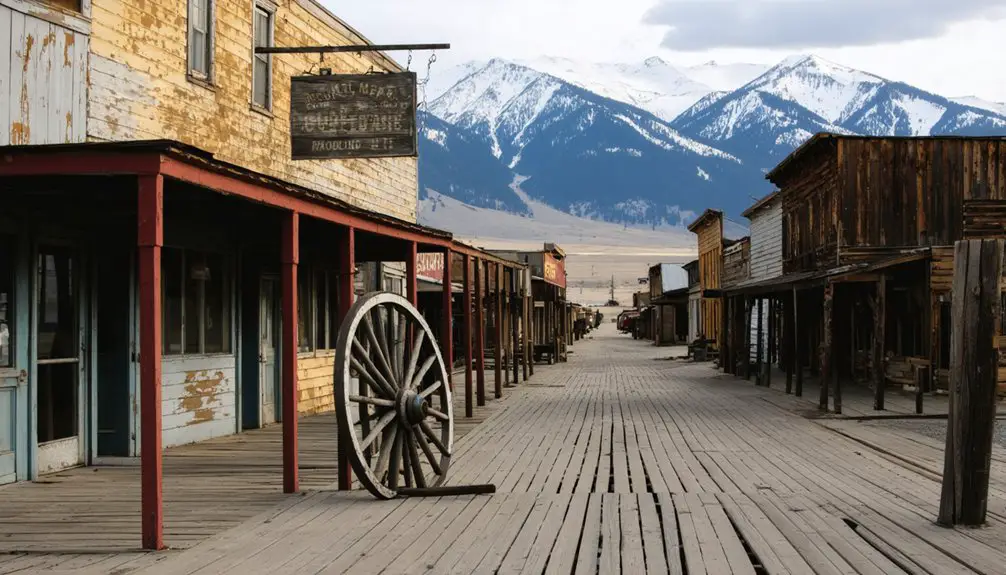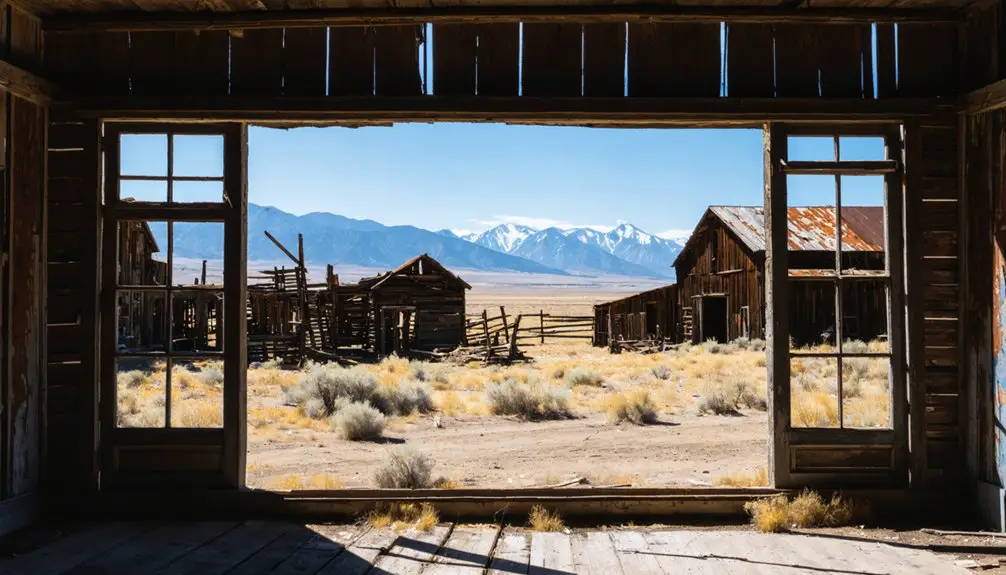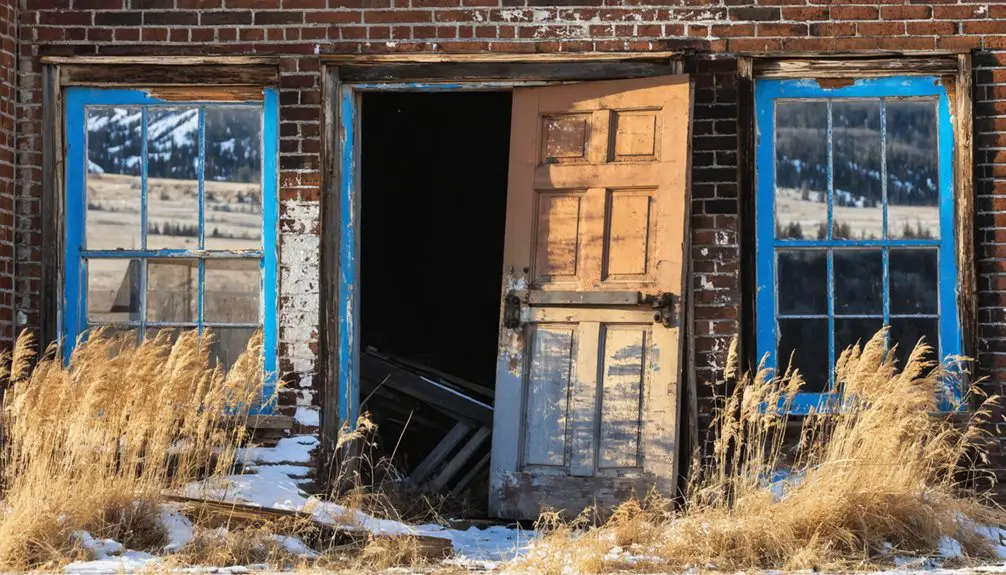You’ll discover one of America’s most authentic ghost towns in Virginia City, Montana, where an 1863 gold strike launched a mining boom that yielded up to $150 million in placer gold. Today, the Montana Heritage Commission preserves 150 certified historic structures, including the 1875 Grace Methodist Episcopal Church and original Victorian-era buildings. Located 80 miles from Yellowstone’s West Entrance, this former territorial capital offers guided tours, stagecoach rides, and ghost walks that bring its wild frontier past to life.
Key Takeaways
- Virginia City began as a gold rush boomtown in 1863 after William Fairweather’s discovery yielded millions in placer gold near Alder Creek.
- The Montana Heritage Commission preserves 150 certified historic structures, maintaining Virginia City as an authentic living ghost town museum.
- Despite its “ghost town” status, Virginia City remains partially inhabited and welcomes over 70,000 summer visitors exploring its Victorian-era buildings.
- Visitors can experience the town’s haunted history through nightly ghost tours departing from the historic Bale of Hay Saloon.
- The town’s preservation includes original Gold Rush era architecture, stagecoach rides, and period-authentic accommodations for immersive historical experiences.
The Birth of a Mining Frontier
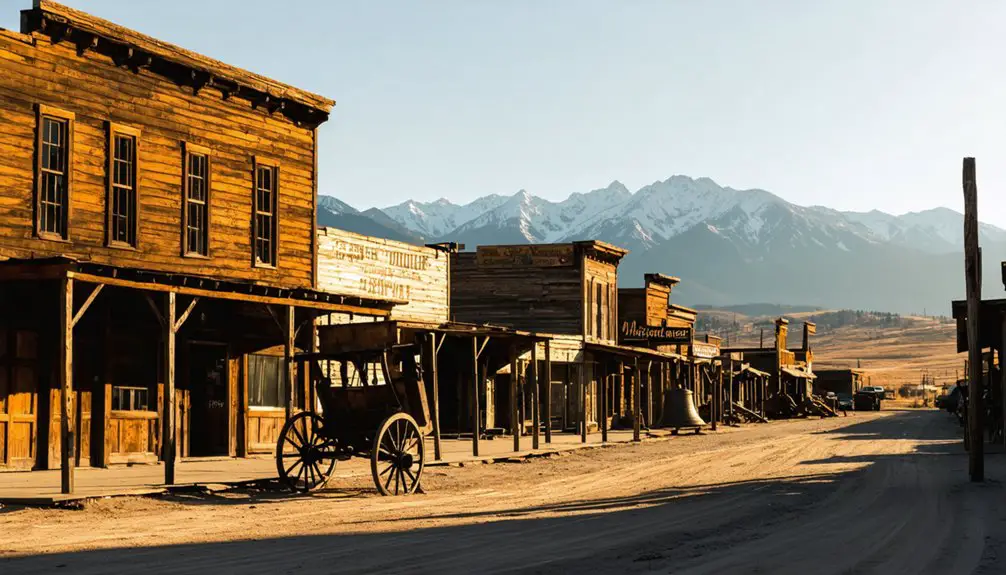
When six prospectors led by William Fairweather struck gold near Alder Creek on May 26, 1863, they couldn’t have imagined the transformative impact their discovery would have on Montana Territory. Their first pan yielded $2.40 in gold, signaling the birth of one of the West’s richest mining frontiers.
A small pan of gold worth $2.40 sparked a rush that would forever change Montana’s landscape and destiny.
Within three years, Virginia City boasted the territory’s first telegraph in Montana.
You’ll find that prospector life quickly transformed the gulch as news spread, drawing thousands seeking their fortune.
The miners established order through self-governance, setting up claim registrations and district rules while utilizing basic mining techniques like sluice boxes for placer mining.
Virginia City emerged as their central hub, initially planned as Varina but renamed for political reasons. The settlement grew rapidly along the hillsides, with miners building camps and cabins that would shape Montana’s destiny.
Gold Rush Fever and Rapid Growth
News of Fairweather’s discovery ignited an unprecedented gold rush fever that transformed Virginia City into one of the West’s most significant boomtowns.
Within weeks, you’d have witnessed thousands of prospectors flooding Alder Gulch, their basic mining techniques yielding staggering amounts of placer gold valued between $30-150 million.
Law and Order in the Wild West
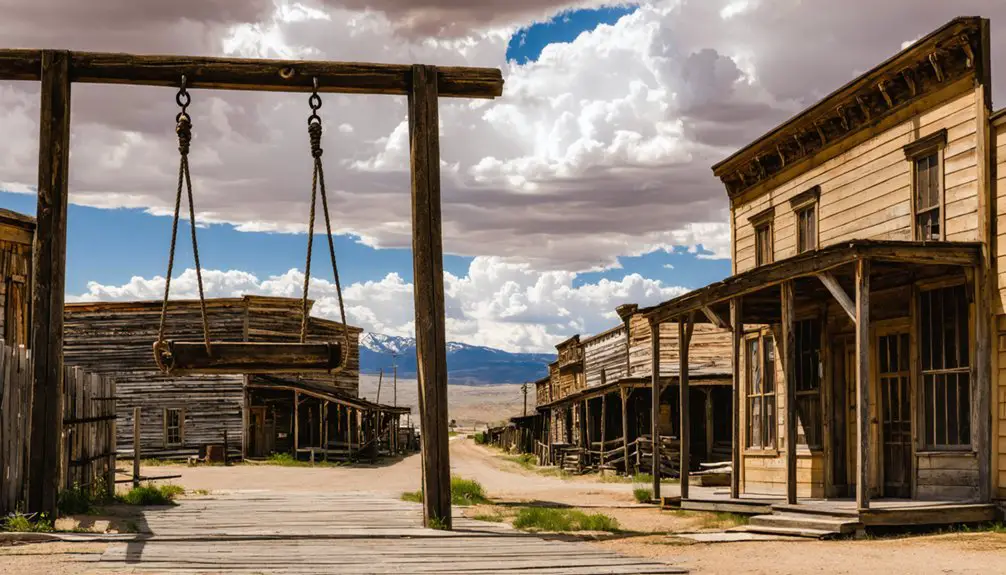
As Virginia City’s population exploded with fortune seekers in 1863, a wave of lawlessness gripped the burgeoning settlement, compelling citizens to establish their own brand of frontier justice.
In response to rampant murders and robberies by notorious “road agents,” the Vigilance Committee formed to restore order in the absence of official law enforcement. The group emerged after over 100 travelers had been killed in road agent robberies during the fall of 1863.
You’ll find evidence of their impact along Wallace Street, where they executed five road agents in January 1864. The vigilantes’ warning symbol “3-7-77” became deeply embedded in Montana’s heritage and still appears on Highway Patrol badges today.
While their actions helped tame the wild frontier, the controversial legacy of vigilante justice reflects both the establishment of community order and the darker side of extrajudicial violence.
Victorian Architecture Frozen in Time
The Victorian architecture of Virginia City stands as a remarkable tribute to Montana’s gold rush era, preserved through decades of careful stewardship.
You’ll find Gothic-arched entries and intricate window tracery adorning buildings like the 1875 Grace Methodist Episcopal Church, while stucco-covered rubblestone walls showcase the period’s durable construction methods.
The Bovey family initiated essential architectural preservation efforts in the 1940s, stabilizing fragile structures and reconstructing fallen buildings.
Thanks to the pioneering Bovey family’s 1940s preservation work, Virginia City’s historic buildings found new life through careful restoration.
Today, the Montana Heritage Commission continues this legacy through federal grants and community-driven restoration projects. Traditional craftsmen employ period-appropriate materials to maintain the town’s historic authenticity.
You can explore an authentic frontier townscape where Victorian details merge with Western practicality – from false-fronted commercial buildings to simple framed houses.
This living museum, earning National Historic Landmark status, captures the exact moment when Montana’s territorial capital flourished during the 1863-1875 boom period.
From Bustling Capital to Living Museum
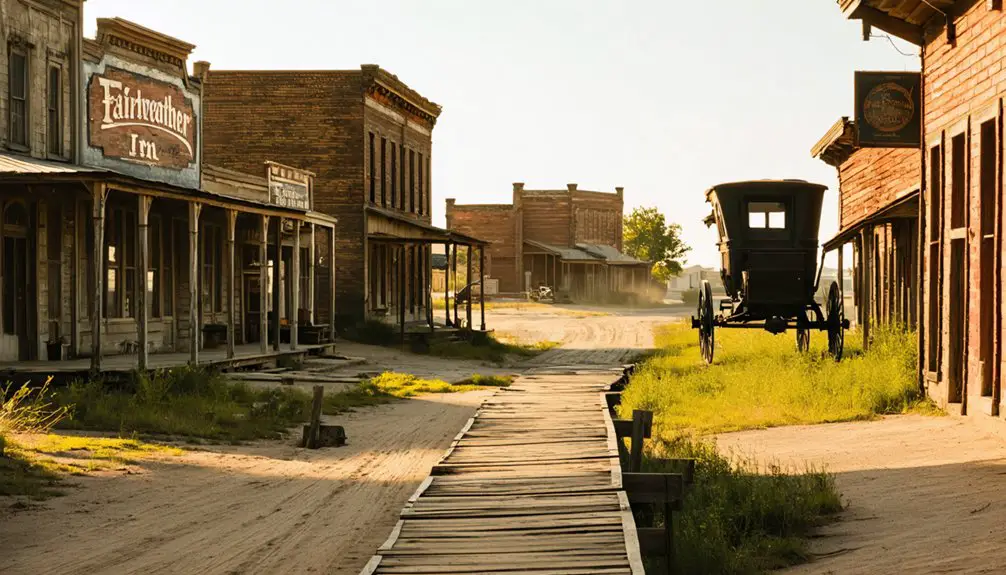
During Montana Territory’s formative years, Virginia City transformed from a rowdy mining camp into a sophisticated territorial capital, reaching its zenith between 1865-1875.
You’ll find a town that once bustled with 30,000 residents during the 1864 gold rush, though the capital relocation to Helena in 1875 triggered a dramatic population decline.
Today, you’re walking through one of America’s most authentic gold rush towns, preserved through the dedicated efforts of Charlie and Sue Bovey since the 1940s.
The town’s 150 certified historic structures now serve as a living museum where you can experience the Old West through period-appropriate storefronts, Victorian architecture, and authentic establishments.
From the Star Bakery to the Bale of Hay Saloon, each building tells the story of Virginia City’s remarkable journey from territorial capital to cherished historic landmark.
Planning Your Visit to Montana’s Best-Preserved Ghost Town
Located 80 miles northwest of Yellowstone’s West Entrance, you’ll find Virginia City nestled in the Rocky Mountains, offering both day trip and overnight experiences in its preserved Victorian-era accommodations.
During its heyday, the area produced an incredible estimated $100 million in gold from the rich deposits of Alder Gulch. Today, the town welcomes over 70,000 visitors annually.
You can maximize your visit during peak summer season when living history events, theatrical performances, and heritage trade demonstrations run in full swing.
The Visitor Information Center provides essential maps and schedules for guided tours that showcase Boot Hill Cemetery, the historic commercial district, and interactive experiences like steam train rides and gold panning demonstrations.
Getting Here and Lodging
Situated roughly 50 miles west of Yellowstone National Park, Virginia City welcomes visitors via U.S. Route 287.
You’ll navigate through “Earthquake country” and mountainous terrain, with the drive from Yellowstone’s West Entrance covering about 90 miles. Be prepared for spotty cell reception during your journey through the Rockies.
For overnight stays, you’ll find authentic Victorian-era accommodations that capture the Old West’s spirit.
The town’s preserved historic homes and businesses now serve as unique lodging options, operating year-round with full services during peak season (Memorial Day to Labor Day).
You’ll want to secure lodging reservations in advance, especially during summer months when these carefully maintained properties fill quickly.
Nevada City Ghost Town, just a mile away, makes for an easy day trip while you’re based in Virginia City.
Peak Season Travel Tips
A well-planned visit to Virginia City requires careful attention to timing and seasonal considerations. For the ideal visitor experience, schedule your trip between Memorial Day and Labor Day when the historic district operates at full capacity. You’ll find both Virginia City and Nevada City’s amenities, shops, and living history demonstrations in full swing during these months. The richest placer gold discovery in Rocky Mountain history makes this a popular destination.
For effective crowd management, consider these strategic timing tips:
- Visit after midday when morning tour groups have dispersed
- Choose weekdays over weekends to explore the preserved 1860s architecture
- Avoid major event days like the Memorial Day parade for a more relaxed experience
The elevation of 5,680 feet demands practical preparation. Pack layers for temperature fluctuations, wear sturdy walking shoes for the historic streets, and bring sun protection for high-altitude exposure.
Local Tours Available
Three distinct tour options let you explore Virginia City’s rich Gold Rush heritage and paranormal past.
You can join nightly ghost tours departing from the historic Bale of Hay Saloon, where ghostly encounters are frequently reported. These tours run Sunday through Thursday at 9 p.m., with additional Friday and Saturday slots at 8 and 9:30 p.m.
For thorough historical narratives, private guided tours include air-conditioned transport from West Yellowstone, visiting both Virginia City and Nevada City. These tours feature expert guides who illuminate the region’s Gold Rush history while providing snacks and lunch. The area yielded approximately 100 million in gold during its peak mining period.
Traditional walking tours and stagecoach rides offer intimate explorations of preserved 1800s businesses and artifacts.
You’ll discover Boot Hill Cemetery, the Thompson-Hickman Museum, and authentic mining-era structures along Virginia City’s historic boardwalks.
Frequently Asked Questions
Are There Any Reported Ghost Sightings or Paranormal Activity in Virginia City?
You’ll encounter numerous ghost stories in the Washoe Club, Silver Queen Hotel, and Piper’s Opera House, where haunted history includes documented apparitions, phantom voices, and paranormal encounters witnessed by locals and investigators.
What Happened to the Original Gold Mining Equipment and Machinery?
You won’t find much original gold mining equipment today – most was scrapped, abandoned, or dismantled after 1937. The dredges were removed, while smaller tools were lost to time or preserved in museums.
How Many Original Residents’ Descendants Still Live in Virginia City Today?
While exact descendant demographics aren’t documented, you’ll find some original families like the Daltons maintain historical lineage there. Among today’s 219 residents, several families trace their roots to pioneer settlers.
Can Visitors Still Pan for Gold in Alder Creek?
You can’t pan directly in Alder Creek due to restrictions, but you’ll enjoy guided gold panning experiences at River of Gold attraction, where they provide authentic paydirt, instruction, and historical context.
What Was the Average Temperature and Climate During the Mining Era?
You’d have experienced a mining climate of mild summers (60s-70s°F) and frigid winters (below 0°F), with historical weather patterns showing 15-20 inches of annual precipitation in this semi-arid mountain setting.
References
- https://www.legendsofamerica.com/mt-virginiacity/
- https://sherilyndecter.com/virginia-city-from-ghost-town-to-tourist-mecca/
- https://southwestmt.com/ghosts/itineraries/virginia-city-to-garnet-ghost-town/
- https://virginiacitymt.com/Experience-The-Old-West/index
- https://en.wikipedia.org/wiki/Virginia_City
- https://montanakids.com/cool_stories/ghost_towns/mining.htm
- https://southwestmt.com/specialfeatures/this-is-montana/communities/virginia-city-montanas-first-incorporated-town/
- https://virginiacitymt.com/Preservation/Area-History
- https://mhs.mt.gov/shpo/docs/NRnoms/MT_MadisonCo_VirginiaCityHD.pdf
- https://www.mtmemory.org/nodes/view/103817
